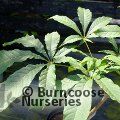AESCULUS indica

<




>
AESCULUS indica
Commonly known as Indian horse chestnut
Full Plant Details - Sun/Soil & other attributes
-
Floweringlocal_floristJanlocal_floristFeblocal_floristMarlocal_floristAprlocal_floristMaylocal_floristJunlocal_floristJullocal_floristAuglocal_floristSeplocal_floristOctlocal_floristNovlocal_floristDec
-
Architectural interest
-
BerriesThese plants have berries.Conkers in the autumn
-
 Pests & Diseases
May be susceptible to horse chestnut scale and leaf-mining moth. canker and honey fungus
Pests & Diseases
May be susceptible to horse chestnut scale and leaf-mining moth. canker and honey fungus -
 Place of origin
India and Himalayas
Place of origin
India and Himalayas -
Deciduous
-
 White
White spotted yellow
White
White spotted yellow -
Panicles
-
Town garden
-
Woodland garden
-
 Palmate
Palmate
-
 Height
10 - 12 metres
Height
10 - 12 metres -
 Spread
5 metres
Spread
5 metres -
Tree
-
 Pruning group 1
Suitable for: Deciduous and evergreen trees, and some deciduous shrubs.
Pruning group 1
Suitable for: Deciduous and evergreen trees, and some deciduous shrubs.
Pruning: Minimal pruning required. Prune wayward or crossing branches to maintain a healthy framework.
When: When dormant in the late winter/early spring. Some in the summer/autumn to prevent bleeding of sap.
-
 Hardy - cold winter
Hardy in most places throughout the UK even in severe winters. May not withstand open/exposed sites or central/northern locations. Plant can withstand temperatures down to -15°C (5°F)
Hardy - cold winter
Hardy in most places throughout the UK even in severe winters. May not withstand open/exposed sites or central/northern locations. Plant can withstand temperatures down to -15°C (5°F) -
Autumn Seasonal Interest
-
Spring Seasonal Interest
-
Fertile moist well-drained soil
-
Tolerates all
-
 Full sun
Full sun
-
 Partial shade
Partial shade
-
 harmful if eaten
Humans-pets(dogs)
harmful if eaten
Humans-pets(dogs) -
Rounded to broadly spreading
View Detailed Plant Description
View Planting Tips and Care Advice
Aesculus - Growing Guide








